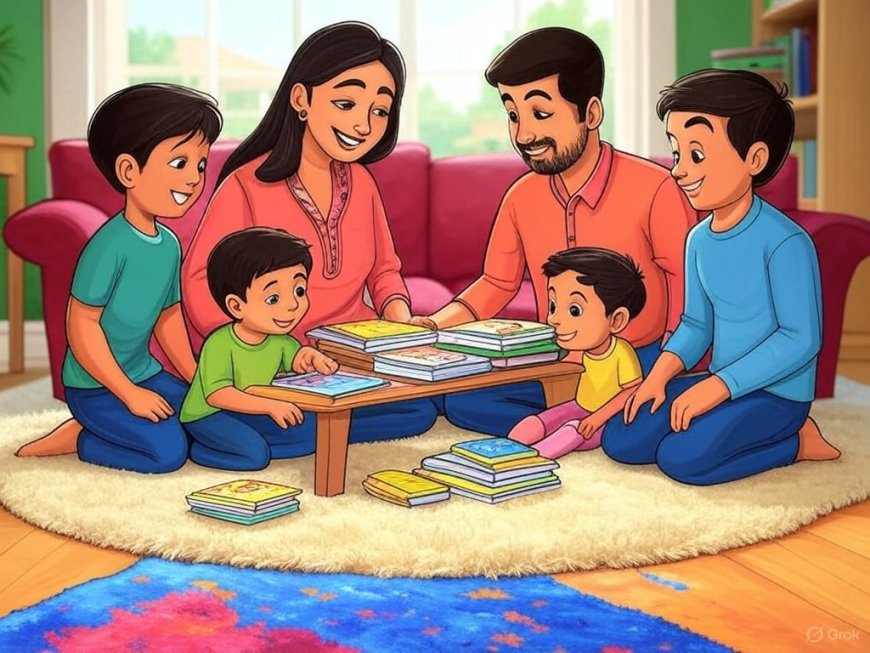Raising Resilient Kids: How Indian Parenting is Embracing Holistic Child Wellness
Explore how Indian parenting is evolving to focus on holistic child wellness by blending tradition, emotional intelligence, nutrition, and mindfulness practices to raise well-rounded, resilient children.

Indian parenting has always emphasized values like discipline, education, and family bonds. But in recent years, as stress and screen time creep into children’s daily lives and anxiety disorders rise globally, parents in India are shifting their approach. They are now blending age-old traditions with modern psychology to nurture a more holistic model of child development.
This movement isn't just about health. It’s about raising children who are emotionally intelligent, physically active, spiritually grounded, and mentally resilient. In this article, we explore how Indian parenting is transforming, what holistic child wellness really means, and how families can adopt practices that nurture body, mind, and spirit.
What is Holistic Child Wellness?
Holistic child wellness focuses on the complete well-being of a child—not just academic success or physical health, but also emotional, mental, social, and spiritual balance.
Key Dimensions of Holistic Child Development:
-
Physical wellness: Nutrition, sleep, activity, and immunity
-
Emotional wellness: Expressing feelings, self-worth, empathy
-
Mental wellness: Focus, creativity, and mental rest
-
Spiritual wellness: Meaning, purpose, and connection (not necessarily religious)
-
Social wellness: Friendships, communication, teamwork
According to the World Health Organization, more than 10% of children worldwide experience mental disorders. Holistic parenting practices help reduce this risk by addressing root causes rather than just symptoms.
Indian Parenting: From Control to Connection
Traditionally, Indian parenting was hierarchical—parents gave instructions, and children followed. But the modern generation of Indian parents is more mindful, emotionally present, and adaptable.
Then vs. Now:
| Traditional | Holistic Approach |
|---|---|
| Focus on grades | Focus on learning + curiosity |
| Strict routines | Flexible, child-led rhythm |
| Discipline by control | Discipline through connection |
| Physical health focus | Emotional + spiritual health equally important |
Parents are now integrating emotional intelligence and positive discipline, inspired by global trends and indigenous practices alike.
Backlink: Parenting Tips by Child Rights and You (CRY India)
Ancient Wisdom Meets Modern Science
India's wellness roots go deep. From Ayurveda to yoga and sattvic diets, Indian culture offers tools that align beautifully with child wellness.
1. Ayurvedic Nutrition for Kids
Ayurveda emphasizes food as medicine. Seasonal, locally-sourced, freshly-cooked meals support immunity and digestion—key for growing children.
-
Ghee, turmeric, and ginger for brain function and immunity
-
Ragi, millets, and jaggery over processed cereals
-
Warm water and tulsi decoctions instead of sugary drinks
Backlink: Ayurveda for Children – Kerala Ayurveda Academy
2. Yoga and Pranayama for Focus and Calm
Children as young as five can safely practice yoga postures and breathing techniques. These help with:
-
Concentration during studies
-
Anxiety and restlessness
-
Better sleep and emotional balance
In many Indian schools, yoga is now part of the curriculum, with proven results in behavior and attention span.
Backlink: NCERT Guidelines on Yoga in Schools
3. Storytelling and Cultural Bonding
Indian families often use stories from the Ramayana, Mahabharata, or Panchatantra not just for moral lessons, but to encourage imagination, critical thinking, and cultural identity.
Try This:
-
Daily 10-minute story time
-
Involve grandparents for intergenerational bonding
-
Ask reflective questions: “What would you have done differently?”
Backlink: The Power of Indian Folktales – Amar Chitra Katha
Emotional Wellness: The New Priority
One of the most visible shifts in Indian parenting today is the willingness to talk about emotions and mental health.
Practices Gaining Popularity:
-
Feelings chart for young children
-
Journaling or gratitude diaries for older kids
-
Using tools like the “worry box” to externalize stress
-
Saying “I’m proud of you” more often
Therapists and child psychologists in India also note a rise in parents seeking preventive counseling—a significant step forward.
Backlink: Children's Mental Health by Fortis Healthcare
Holistic Daily Routine for a Child
A balanced day can look like this:
| Time | Activity | Wellness Dimension |
|---|---|---|
| 6:30 AM | Wake up + oil massage | Physical + sensory grounding |
| 7:00 AM | Light yoga + breathing | Mental clarity |
| 7:30 AM | Breakfast (ragi dosa, fruit) | Nutrition |
| 9:00 AM – 1:00 PM | School/study | Intellectual development |
| 1:00 PM | Warm lunch, screen-free | Digestive health |
| 4:00 PM | Outdoor play | Physical + social |
| 6:30 PM | Storytime or prayer | Emotional + spiritual |
| 8:00 PM | Light dinner + early bed | Rest + recovery |
Schools, Pediatricians, and Tech: Everyone’s Role
Many urban schools in India are adopting mindfulness periods, art therapy, and social-emotional learning. Pediatricians are also educating parents on behavioral milestones and mental wellness.
Additionally, apps like Thinkerbell Labs’ ‘Annie’ help children with special needs learn through inclusive tools.
Backlink: Thinkerbell Labs: Inclusive Learning for Indian Children
Final Thoughts: Parenting with Presence
Indian parenting is at a powerful crossroads—where tradition meets innovation. The shift toward holistic child wellness doesn’t mean abandoning old values. It means adapting them to today’s needs with empathy, awareness, and intention.
Raising children in today’s fast-changing world requires more than academic achievement. It calls for nurturing resilient hearts, curious minds, and strong inner foundations. Indian families, with their rich cultural frameworks and growing openness to change, are uniquely poised to lead this wellness revolution.
What's Your Reaction?
 Like
0
Like
0
 Dislike
0
Dislike
0
 Love
0
Love
0
 Funny
0
Funny
0
 Angry
0
Angry
0
 Sad
0
Sad
0
 Wow
0
Wow
0



















































